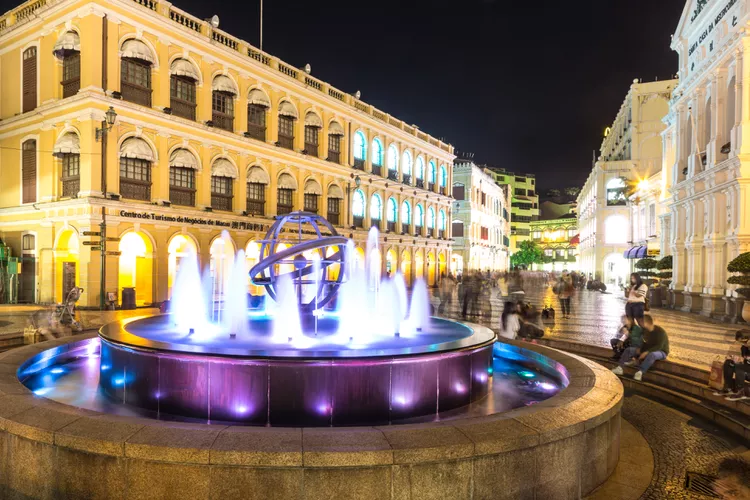Summary
Macau has been far more protective of its colonial heritage than Hong Kong and, for the most part, the churches, squares and government buildings constructed by the Portuguese are still standing throughout the city.
Most of the best Portuguese Macau sights are clustered around the Largo de Senado. These attractions can all be visited in under three hours, with a further hour needed to visit the Dom Pedro Theatre and Moorish Barracks. Directions, where necessary, are provided in italics. Visitors can obtain a map from the Macau Tourism Office on Leal Senado, where the tour starts.
Largo Do Senado

Once the heart of Portuguese power in the city, Largo do Senado, or The Square of the Senate, dazzles with decorative mosaic cobbles and is flanked by grand buildings adorned in shades of pink and yellow. The square embodies a colonial Portuguese style, making it an ideal spot for photography.
Leal Senado

The centerpiece of the square (and the city), the Leal Senado, is a whitewashed building featuring wooden green windows, wrought iron balconies, and vibrant flowers in bloom. Built in 1784, this structure once housed the Portuguese planning of their Asian conquests. Today it serves as the Mayor’s Office and a public library.
Leal Senado’s name, meaning Loyal Senate, was earned due to Macau administration’s resistance to Spanish occupation in the 17th century. Notably, visitors can see the loyal inscription added to the entrance hall at the request of King Joao IV. Don’t miss the quintessential Portuguese blue mosaic tiles lining the staircase leading to the library.
The Holy House of Mercy

On the eastern side of the square lies The Holy House of Mercy, a neoclassical building that embodies charitable work, founded in the 16th century. Interestingly, over the years, it served various roles, including as a refuge for those in need and as a site for Macau’s first lottery ticket sale, all for charitable purposes. Today, it features a small museum celebrating the Society’s charitable efforts in Macau, showcasing artifacts including the skull of its founder, Dorn Belchior Carneiro.
St Dominic’s Church

Located at the northwestern end of Largo do Senado, St Dominic’s Church showcases its rich, pastel yellow façade complemented by tall, green, wooden shuttered doors and windows. The church engages a diverse congregation and offers services in Cantonese, Portuguese, and English.
In the rear area of the church, through an expansive veranda, visitors will find a small museum featuring an impressive collection of sacred art from both Macau and Portugal, with artifacts dating back to the 16th century, including various paintings and statues reflecting a range of artistic styles.
The Ruins of St Paul’s

From the church, take Rua da Pahla, turning into Rua Sao Paulo to reach The Ruins of St Paul’s.
Undoubtedly Macau’s most significant tourist attraction, the Ruins of St Paul’s are what remain of a 16th-century Jesuit church, once deemed the most important Christian establishment in Asia. Tragically, the church was almost entirely destroyed by a fire in 1835, leaving only the remarkable façade, adorned with intricate carvings depicting biblical scenes and Asian-inspired imagery.
Monte Fort

At the top of stairs, to the right of St Paul’s façade you’ll find the escalator to the Monte Fort. Look for Macau Museum signs, which is built into the fort’s foundations.
During its construction in 1617, Monte Fort served as a stronghold amid fears of invasions by nonbelievers. Covering over 10,000 square meters, this fortress was built to withstand sieges lasting over two years.
Interestingly, the fort experienced minimal action, with cannons only being fired twice. Once, a misfire by a Jesuit priest struck the Dutch invaders, who attempted to invade the island, resulting in a spectacular explosion of their gunpowder ship, ultimately saving Macau from siege.
Dom Pedro Theatre

Having completed the first half of the tour, you can now proceed to visit the Moorish barracks, which is highly recommended along with a variety of other interesting sights. Simply retrace your steps back to the Largo Do Senado, cross Avenda de Almeinda Riberio, walk east from the Leal Senado, and turn south onto Rua Central. The Dom Pedro Theatre is located on the right-hand side.
During its opening in 1860, the Dom Pedro Theatre offered lively entertainment, including a bar and restaurant, and quickly became a cultural hub for Macau’s Portuguese community. After being restored following years of abandonment, the theatre is characterized by colonial arcades and a grand entrance, adorned in a pastel green hue with white accents.
Largo do Lilau

Return to Rua Central, continuing south, where the street will transform into Rua de Sao Lourenco and then Rua da Barra, leading to Largo do Lilau.
Largo do Lilau may lack the grandeur of other squares, yet it offers an intimate glimpse into Macau’s Portuguese heritage. The square is surrounded by charming, pastel-colored houses featuring wooden shutters, representing an authentic slice of small-town life in the heart of Macau. Legend has it that drinking from the fountain in the square guarantees your return to Macau.
Moorish Barracks

Continue along Rua Barra to locate the Moorish Barracks.
Macau served as a crucial link in the vast expanse of the Portuguese Empire, which connected regions from Goa to Malacca. In the late 1800s, the Portuguese established a garrison of Indian police, housed in the Moorish-inspired barracks. This unique building showcases a blend of Portuguese, Indian, and Moorish architectural influences, primarily evident in the horseshoe arches adorning its wide verandahs. Today, the barracks serve as a base for the city’s Maritime Authorities, although visitors can explore the exterior.





